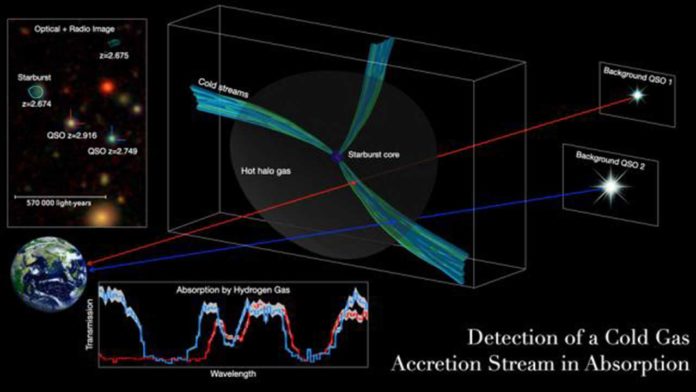Large galaxies found in the early universe needed a lot of cold molecular gases to coalesce and grow. Yet, where did these early, super-sized galaxies get that much cold gas when they had hotter surroundings?
A new study offers direct evidence of cold gas pipelines that fed the early, massive galaxies. Astronomers, led by the University of Iowa, report direct, observational evidence of streams of cold gas they believe provisioned these early, massive galaxies.
They detected cold gas pipelines that cut through the hot atmosphere in the dark matter halo of a huge early universe, providing the galaxy’s materials for star formation.
Almost two decades ago, cosmic filaments ferried cold gas and embryonic, node-shaped galaxies to a dark matter halo during the early universe, where they all clumped together to form massive galaxies. The theory assumed the filaments would need to be narrow and densely filled with cold gas to avoid being peeled off by the hotter surrounding atmosphere.
In this study, scientists studied a gaseous region surrounding a massive galaxy formed when the universe was about 2.5 billion years old. It took five years to determine its exact location and distance (through its redshift).
Because of its dusty environment, scientists used the Atacama Large Millimeter/Submillimeter Array as its environment can only be seen in the submillimeter range of the electromagnetic spectrum.
Hai Fu, associate professor in Iowa’s Department of Physics and Astronomy, said, “It is the prototype, the first case where we detected a halo-scale stream that is feeding a very massive galaxy. Based on our observations, such streams can fill up the reservoir in about a billion years, which is far shorter than the amount of time that was available to the galaxy at the epoch that we were observing.”
Scientists also discovered two background quasars that are projected at close angular distances to the target galaxy. The quasars’ light penetrating the halo gas of the foreground galaxy left chemical “fingerprints” that confirmed the existence of a narrow stream of cold gas.
Those chemical fingerprints showed the gas in the streams had a low concentration of heavy elements such as aluminum, carbon, iron, and magnesium. Since these elements are formed when the star is still shining and are released into the surrounding medium when the star dies, scientists determined the cold gas streams must be streaming in from outside, rather than being expelled from the star-making galaxy itself.
Fu said, “Among the 70,000 starburst galaxies in our survey, this is the only one associated with two quasars that are both nearby enough to probe the halo gas. Even more, both quasars are projected on the same side of the galaxy so that the same stream can block their light at two different angular distances. So, I feel extremely fortunate that nature provided us this opportunity to detect this major artery leading to the heart of a phenomenal galaxy during its adolescence.”
Study co-authors include Rui Xue, who was a postdoctoral researcher at Iowa and is now a software engineer at the National Radio Astronomical Observatory; Jason Prochaska from the University of California, Santa Cruz; Alan Stockton from the University of Hawaii-Honolulu; Sam Ponnada, who graduated from Iowa last May and is a graduate student at the California Institute of Technology; Marie Wingyee Lau, from the University of California, Riverside; Asantha Cooray, from the University of California, Irvine; and Desika Narayanan, from the University of Florida.
Journal Reference:
- Hai Fu et al. A Long Stream of Metal-Poor Cool Gas around a Massive Starburst Galaxy at z = 2.67. DOI: 10.3847/1538-4357/abdb32
